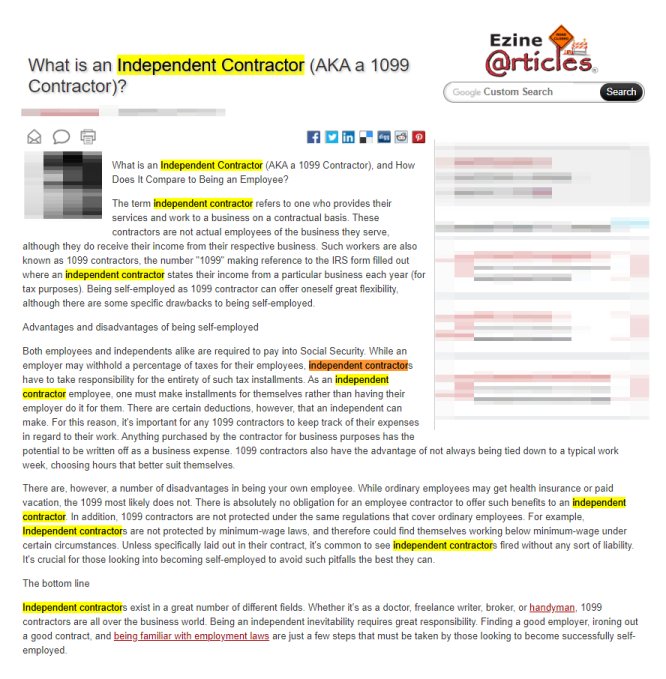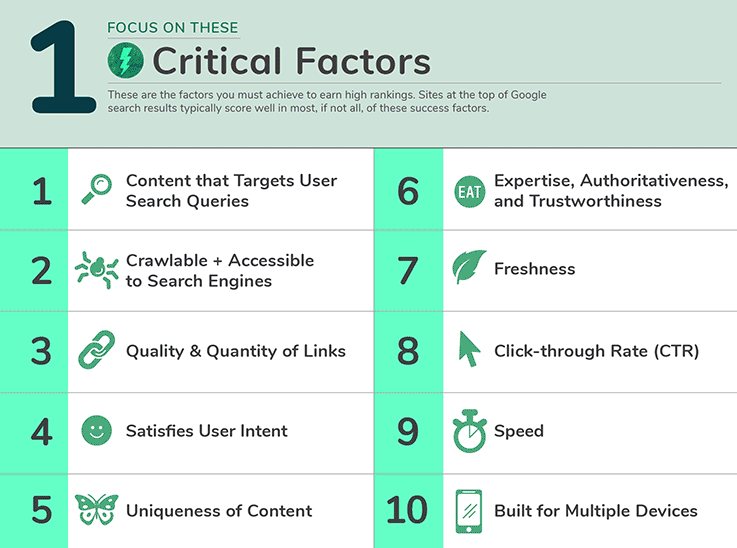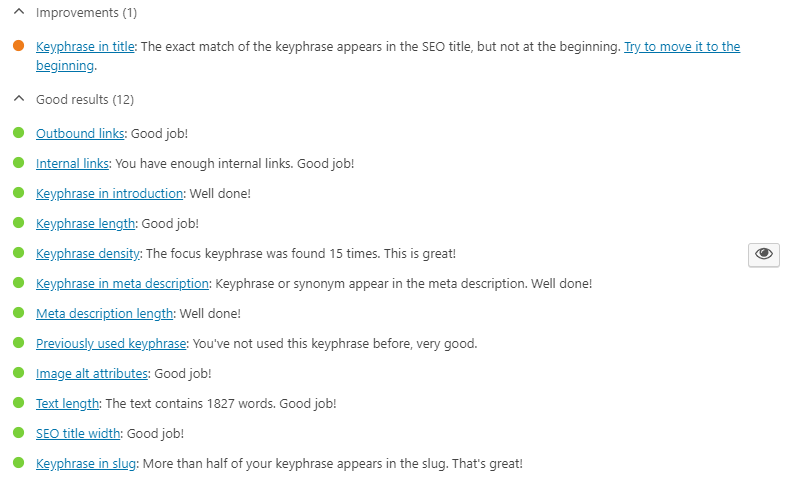
Is there such a thing as a “perfect” piece of SEO content?
Well, it depends on who you ask.
You might think that strict optimization would be unnecessary in an era where 91% of pages receive no traffic from Google, right?
The problem is that search engine competition is absolutely fierce at the top. That is, approximately two-thirds of traffic goes to the top five Google results.
This leads to the phenomenon of marketers following rigid SEO guidelines that they consider to be non-negotiable.
And likewise, this results in a ton of unreadable, over-optimized content
Based on my own research and anecdotal experiences, pursuing “perfect” SEO content is a fool’s errand. Below I’ve broken down the five reasons why (and what writer should do instead)
1. Readers Can Recognize Overly-Optimized Content (Spoilers: They Don’t Like It)
News flash: the average reader loathes SEO.
I mean, they hate it. Can’t stand it.
And while you can scoff at scathing criticisms of SEO such as “How Google Ruined the Internet,” the author isn’t really saying anything that’s wrong.
Give your readers some credit. Believe it or not, they recognize SEO content when they see it.
For example, people have caught on to the epidemic of recipe blogs that bury instructions between walls of text.
Can SEO content find a balance between readability and optimization? Absolutely.
This is especially true if you’re writing for businesses. One of the big benefits of B2B blog content is that your audience is probably at least peripherally aware of SEO. They understand the game and aren’t going to fault you for trying to rank for keywords.
Likewise, most B2B content is educational in nature. In-depth guides and how-to blogs provide natural opportunities to integrate keywords versus trying to cram ‘em in.
The problem with the concept of perfect SEO content is that it ignores basic UX.
If someone’s visiting a recipe blog, they want a recipe. They don’t want a 3,000-word personal narrative. Unfortunately, search engines sometimes point to the latter rather than the former.
2. So Much SEO Advice Is Vague, Contradictory or Anecdotal
It might be cliche but there is no “right” way to do SEO.
Sure, there’s plenty of conventional wisdom.
Google typically prefers longer-form content. Titles and headers should probably contain your target keywords. That sort of basic stuff.
But then there’s a lot of nitpicking, arguing, and anecdotal evidence.
Like, “what helped Expert Smith’s site rank doesn’t work according to Expert Brown” and so on.
Here’s another example. In a single Google search, I can find posts from experts breaking down why link-building still works while another proclaims link-building is not the future of SEO.
Oh, and there are also a lot of people who kind of just spout nonsense or live and die by cliches like “content is king.”
But let’s say you listen to SEO experts and take them at their word.
I could probably pick out guides from the likes of Moz, SEMrush, Backlinko and Ahrefs and find a bunch of conflicting advice (in addition to a lot of good advice, mind you). Each of them could outline what perfect SEO content looks like and none of them would technically be wrong.
The takeaway here is that trying to navigate and implement SEO advice can be daunting. How do you know what works? How do you know if these folks are practicing what they preach?
Perhaps the best way to learn what works and what doesn’t work in SEO is to take a DIY approach. Find the common threads between what legit SEOs say and see if their tactics result in rankings.
3. Search Algorithms are Fickle and Ever-Changing
Look no further than the history of the Google algorithm as evidence of how quickly sites can rank or tank.
Guidelines and expectations for SEO change as readers and consumers evolve and rightfully so. Google’s algorithm has become more sophisticated and expects writers to step up to the plate.
And so what was considered to be “perfect” SEO content back in 2010 would probably be considered trash today.
Actually, I can prove it. Check out this overly-optimized, spammy post I wrote as a content writing intern in college.

Horrifying, huh? But hey, this was the norm. This was “perfect,” in a sense.
Of course, a 500-word, keyword-stuffed mess just isn’t going to cut it anymore. Anecdotally, I feel that SEO guidelines and best practices have been fairly consistent for the past four or five years.
For me, the definition of “quality content” for SEO is long-form authoritative writing that contains original research and plenty of visuals while targeting relevant search terms.
Wordy, I know.
That said, this definition goes hand in hand with most of Google’s ranking factors which are actually in our control. Focus on these factors and you’re likely golden.

The idea that writers can put together something that appeases all 200+ of Google’s ranking factors is ridiculous. The same logic applies to someone trying to write perfect SEO content. Again, it’s a waste of time.
4. Rigid Instructions Kill Creativity and Readability
Maybe it’s because I’ve been doing this for a decade, but dealing with keywords and on-page SEO elements isn’t rocket science.
Confession: many of my top-performing blog posts were written without any specific SEO guidelines in mind.
Yeah, I’m getting my keywords in my titles and header tags. I’m working in some secondary phrases, too.
But I don’t have a perfect SEO content template that I’m married to. Even the gold standard” green bullets” of tools like Yoast aren’t the be-all, end-all of optimization (despite popular belief).

Every now and then I’ll see clients with insanely detailed instructions regarding keyword density, placement, internal linking and so on.
And as noted earlier, these clients aren’t necessarily wrong in this approach if it’s proven to work for them. They’re smart people who know SEO.
Yet the problem with this approach is that it kills some of your creativity as a writer. Perhaps that’s harsh, but if you’re being asked to use your target keyword as the opening words of your post, that’s by default going to limit the angles you can take with your intro.
My impression is that super strict SEO is really only necessary if you’re laser-focused on beating a particular post or are trying to crack the elusive top five results at all costs.
But unless you’re in that specific situation, is it worth alienating your audience or getting zero social shares for the sake of optimization? I figure we both know the answer to that.
5. Obsessing Over Optimization Takes Away from Time Spent Writing
I hate to be one of those guys that quote dead literary figures in his blog posts, but perhaps Voltaire said it best: “Perfect is the enemy of good.”
Time spent agonizing over what constitutes perfect SEO content is ultimately time spent, you know, not writing.
Let’s assume that the average blog post takes approximately four hours to write.
How long do you really need to spend nitpicking and fine-tuning your post? You could spend hours debating keywords or link placement and see absolutely nothing in return for your time.
As noted in my list of B2B blogging mistakes, posting something purely for the sake of optimization doesn’t do you any favors.
Yeah, you might get a few impressions in search. But will that result in leads? Customers? Clicks?
Listen: as long as you’re paying attention to your readers’ search intent and the best practices of Google as highlighted throughout this post, you’re already way ahead of the curve in terms of SEO content.
Start there and keep writing.
Okay, But Does Perfect SEO Content Exist?
Probably not.
And we don’t need to pretend as if it does.
There doesn’t need to be more mediocre content disguised as “optimized” floating around in the SERPs.
So don’t sweat being “perfect,” whatever that means. Trust me: you’ll be a better writer for it.
Agree? Disagree? Want to yell at me about my lukewarm takes on SEO? Feel free to reach out to me on Twitter or message me directly.
This post was last updated on 4/15/2020.
Leave a Reply